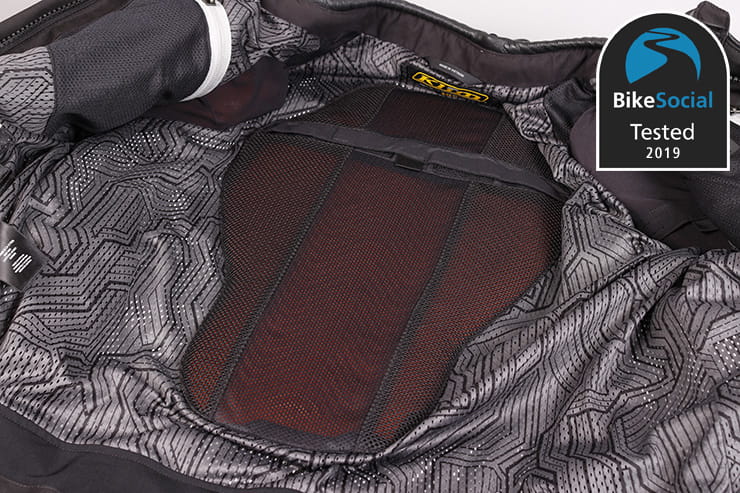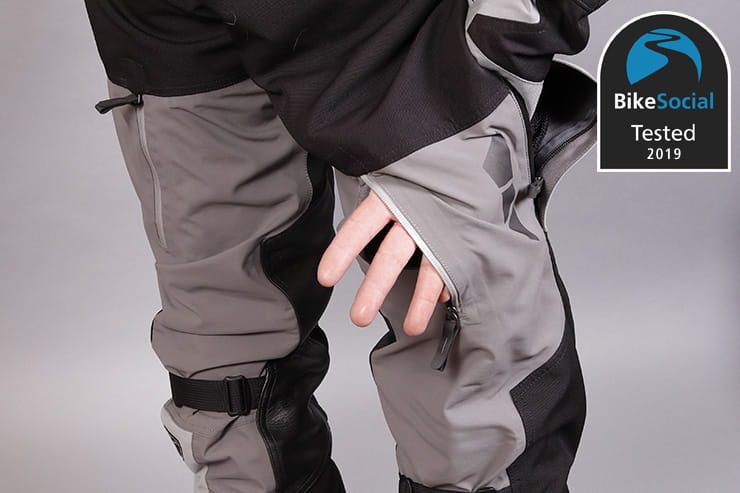Date reviewed: January 2019 | Tested by: John Milbank | Price: £715 (jacket); £549 (trousers) | www.adventure-spec.com
Well known for its adventure-focussed riding kit, the new Klim Latitude jacket and trousers are designed as ‘the ideal touring companion’. With a laminated Gore-Tex construction and outstanding levels of ventilation, it promises to offer versatile protection for riding in almost any climate.
I’ve been using it on a variety of bikes throughout the winter, covering just under 2,000 miles…
Fit
Fit is of course very subjective, so always try any gear on before you buy. I’m 5’10” and 85kg – the size 52 jacket fits me extremely well, with an ideal length to the arms and a good cut around the chest and waist.
The size guide suggested I should have the size 50 trousers (in Rukka, I’m a 50), but these were too tight on my hips – the 52s were perfect, with the waist adjustment allowing me to set them so they’re snug, and stay up while I’m walking around without the need for a belt or braces.
Laminated bike kit has a reputation for being stiff and unwieldy, but this is very comfortable and easy to wear all day (on and off the bike).
Protection and certification
Klim is to be applauded for its responsible attitude to rider protection, given that it has complied with the new CE standards. The Latitude jacket and pants are both approved to the new AA rating, giving riders a commendable level of confidence in the abrasion and burst-resistance of this textile kit.
The fitted D3O armour all meets (or exceeds) Level 2 protection, with knee and hip protection in the pants, as well as elbow, shoulder and back protection in the jacket.
I found the jacket armour, while inevitably thicker than Level 1 kit, to be comfortable and extremely well positioned. On the elbow, it cups your arm well, and is large enough to offer a good degree of protection. It’s unlikely to shift far in a crash, and you can tighten it a little with the strap on the forearm.
The back protector is full-length, and has channels cut into it to aid ventilation.
The hip armour is easily removable, but I prefer to keep it in – it sits in a good position and doesn’t shuffle about.
The knee armour is the only part of the that I found didn’t sit quite right for me. When standing on the bike or walking around, the knee armour sits perfectly – on some textile kit I find it hangs just under my knee cap, making it a bit uncomfortable to walk around. But despite there being a small degree of adjustment in the knee armour pockets, when I’m sat on the bike the armour rides up my leg, leaving only a small amount of protection on my knee cap, and none on my shins. It’s impossible to say where it would be in the event of a crash, but I’d have much preferred larger armour here, more akin to that found in the Rukka Navigattor. Try the kit on while standing and sitting on the bike to decide if it works for you.
Reflective sections add to the safety-conscious design, and a hi-viz design is also available.
Cordura and goat leather are used in the areas most likely to hit the ground, so while light in weight, the Klim does feel impressively tough for textile kit.
From April 21 2018, all new motorcycle clothing is deemed to be Personal Protective Equipment (PPE). To meet this legislation, it must be tested to a recognised standard. For more information on the new laws, click here.
Pockets
The trousers have a pair of front hip pockets, and one on the thigh, but as the fit is so snug (which I prefer), I don’t tend to use these while riding. If I’m wearing the trousers all day at work, I pop my phone and wallet into them, but it’s tight.
The jacket is well equipped, with four zipped internal pockets (one has a headphone hole), one on the left forearm (for credit card or toll tickets), as well as two waist and two chest pockets (which can also be opened to act as vents).
The waist pockets have vertical zips; great if you want to tuck your hands in to keep them warm, and the positioning (with storm flaps) means they’ve not leaked, but I prefer a horizontally-zipped pocket. When taking items out of these – particularly with gloves on – it’s too easy to drag something else out with it. I’m also constantly checking that I’ve remembered to zip them right up, for fear of losing my phone or wallet on the motorway.
Global (and maybe London!) riders may well appreciate the ‘secret’ pocket hidden behind the back protector – a great place to stash travelling money and passport in more hazardous parts of the world.
Fastening
The trousers fasten with a zip fly and two secure poppers at the waist, with zips on the bottoms of the legs, and poppers to tighten them around your boots. I’ve had no problem using them with both Daytona Road Star boots, and TCX Drifter adventure boots.
The jacket’s YKK main zip is pleasingly chunky and easy to operate, with two toggles, allowing you to open the bottom up if necessary. The zip’s covered by a very effective storm-flap, and a Velcro-secured second cover, with a popper at the bottom.
The neck only has a small Velcro fastener, and I do find this to be a slight weak-point. A draw-string allows you to cinch the top of the collar more tightly around your neck, but there’s no real adjustment in the fastener, and it has a tendancy to come open at times. It’s also a bit bulky at the throat, something I’m conscious of before I get on the bike (especially with some undercoats on), but not so much when I ride. On occasion, I’ve found it a little cumbersome when looking down, so this is something you’ll want to check with your own lid (I’ve generally been wearing a Shoei Neotec II).
The collar can be clipped back for increased ventilation in the hotter months, but it’s a shame a removable storm collar isn’t supplied, as these can really improve warmth in the winter.
The cuffs have a simple Velcro strap to tighten them up – this works fine as long as you want your gloves over the top, but for the best weather protection, it’s generally advisable to tuck them under your jacket. My Knox Coverts were easy enough to get under one cuff, but fiddly when it came to getting them under the other. My winter Held 2-in-1 gloves are hard to get under one cuff, and very awkward to put under the other – to the point that I gave up trying.
The trousers join to the jacket with a zip at the back – this is rather small and difficult to operate, though it does get a lot easier with muscle memory. I’d have preferred to see this zip go further around the waist, and be more chunky.
Adjustment
Besides the lower leg and forearm straps that help to keep the armour in place (they’re less effective on the leg), a waist strap draws the jacket in well. A snug fit is important not only to keep armour in place, but also to avoid material rucking up in a crash, which can cause it to be more easily damaged. It’s also really annoying if it flaps in the wind – something I’ve not suffered with this kit.
Ventilation
The Kilm’s ventilation is extremely impressive. On the jacket, the forearms each carry a waterproof zip that allows air to blow right up the arms. The chest has a pair of long zips by the arms, with another long pair on the lower back to allow all that air to blow out, taking body heat with it.
The trousers have a long zip on the front of either leg, and another at the rear – this allows a huge amount of air to blow through, but it does expose the mesh liner a little. It’s more vulnerable in a crash, but it’s very effective.
This is without doubt the coolest laminated Gore-Tex kit I’ve ridden in; in hot climates, it’s certainly something I’d recommend.
Warmth
There’s no thermal liner supplied, and while the impressive ventilation is easily fully closed, the light, thin design of this kit makes it cold in the winter. For longer trips I’ve worn it with my Keis X25 heated jacket, but for the shorter commute I usually just put a quilted down jacket on underneath.
For a touring jacket in the UK, I’m surprised a quality thermal liner isn’t supplied, though many riders around the world would no doubt have little use for one. If you need it, make sure you have something suitable already, or budget for some additional layers.
I wear a pair of long-legged base-layer pants when covering distance, so I haven’t missed having a thermal liner here – I rarely fit one on my other kit.
Liner
The lining is a lightweight, tough, cool-feeling mesh that doesn’t get too sticky, while the armour is held in a stretchy, equally cool-feeling material.
Waterproofing
Despite the impressive ventilation capabilities, I’ve been totally dry in the Latitude jacket and trousers.
Laminated kit is much quicker to dry than typical drop-liner clothing as the outer layer doesn’t wet-out; it can be quickly shaken dry. Once you’ve used it. It’s very hard to go back. The Gore-Tex two-layer system works very well, and while it does add cost, laminated bike gear is an investment well worth making for any all-year biker.
Warranty
All of Klim’s kit carries a lifetime warranty, which guarantees them to be ‘free of material, manufacture or workmanship defect for the practical lifetime of the product.’ All its Gore-Tex products are also guaranteed to keep you dry for the same period – if your kit has any material or manufacturing defects, Klim says it will repair or replace it, at its discretion.
Of course, this doesn’t cover gear that has simply worn out, though if you crash in it within five years of purchase, and you send photos of the damaged kit, along with an official accident report, Klim will likely replace it. For more details, visit www.klim.com/gear-protection-guarantee
Conclusion
A true long-distance rider – who’ll be tackling all climates and roads – would be well advised to seriously consider the Klim Latitude kit. The reliable waterproofing, tough construction and excellent ventilation make it truly versatile. It’s brilliant adventure kit.
UK-based riders will have some complaints though; the lack of thermal liner will be a disappointment, while little niggles like the worrying waist pockets, flimsy (yet bulky) collar fastener and the positioning of the knee armour will be more of an issue to some than others.
Despite being in the latter camp, as a predominantly UK-based commuter and tourer, I’m still very impressed with the Klim kit; it’s at the higher end of the price range, but it’s impressively tough and versatile. And when I’m riding overseas this summer, those brilliant vents are going to be a god-send.





















